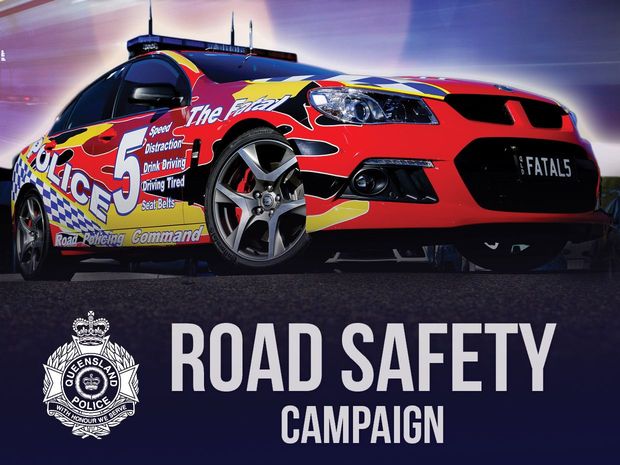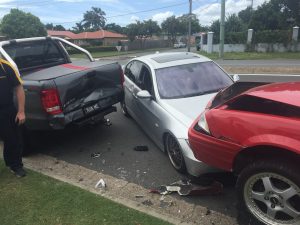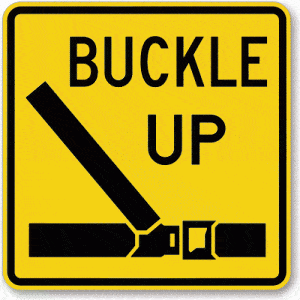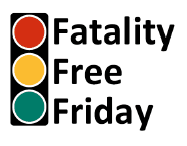Hi, Bob Aldons from Car Business on the job just back from my holiday break. I’ve been looking at the Queensland road toll for 2016 and wondering just how we as a community can do something to arrest the problem. And I’m talking to you Queensland Government and the Queensland Police Service. Road Safety isn’t just about promotion and marketing. Road Safety is about community involvement by everyone.
Both organizations, backed by the general media, show television ads that highlight the consequences of poor driving habits. What I’m not seeing is both of you demanding that drivers overcome less than sufficient ability to drive on the road. Over the last 6 months or so, I’ve also been tracking the un-roadworthiness of vehicles in my own area – Redcliffe – and I must say that I’m gobsmacked at the percentage of cars that don’t appear to comply.
So, what’s the way forward for Road Safety in Queensland? I’m thinking that the baseline here is a lack of ability. We’re still allowing young drivers to achieve their driver’s license without the best possible level of learning. When I first earned my license in 1974, my dad insisted that I take a defensive driving course. And the concepts from that course still stick with me today. Things like taking your foot off the accelerator when you drive through an intersection, looking both ways before proceeding through an intersection on green after you’ve stopped for a red light, looking further down the road than the car directly in front of you. Indicating to turn at the correct distance, paying attention to the road conditions and turning on your headlights when you think you need to rather than waiting for darkness to descend. Surely to improve Road Safety and reduce devastating accidents the Queensland Government has a duty of care to ensure that every driver has the highest level of competence available.
It’s high time that all learner drivers are made to complete an advanced driver course. The investment in this aspect of driving will be a lot more sensible than insisting learner drivers log 100 hours or more before they can take their license test.
Young drivers undoubtedly need to understand the right and wrong way of driving. Extended hours driving with parents or friends don’t allow them to have their inadequacies corrected. If parents aren’t good drivers, the learner driver will only learn bad habits rather than good ones. Professional instructors can eliminate poor outcomes in an advanced driver course. Healthy habits that, when it’s too late to make a difference, will stand them in good stead. And forget about the argument that it’s too expensive. Every single death or significant injury through a vehicle accident costs the Queensland community untold millions of dollars.
And if you allow learner drivers taking the advanced driving course to only have to do say 50 kilometers of driving with another licensed driver, after they’ve completed an advanced or defensive driving course, the ‘minor’ investment in an advanced drivers course will pay off in spades.
So rather than advertise the consequences of poor driving, let’s promote the active elements of driving – aspects that will help those drivers in potentially dangerous situations avoid the incident
ROAD SAFETY – THE FATAL 5
The Queensland Government and Queensland Police Service have promoted the FATAL 5. Five aspects of general driving that combined are a primary reason for the high road toll. Let’s look at them now.

- Distraction and Inattention
- Speeding
- Drunk and Drug Driving
- Failing to wear a Seat Belt
- Driving while tired
Distraction and Inattention
You’re driving a two-tonne missile. Is there any excuse for not paying attention while driving? A little more than a year ago, a young driver, aged just 22 was using her mobile phone in her car without a hands-free device. On the road just outside my business, where the camber of that road is quite severe, she was distracted enough not to notice that camber, veered to her left and impacted two vehicles with her car. Two cars were written off and mine with a $12,000 repair bill.

So not only was she not paying attention to what she was doing but later we found out that she was also over the limit of .05
My insurance company paid for the repair, a fantastic old Holden Commodore SS V8 sedan was written off, and I’m sure that her dad’s BMW would have been written off as well. There’s no excuse for inattention whilst driving. Whether it’s children, mobile phones or anything else, drivers need to concentrate on the job at hand.
Speeding
We’ve all been guilty of speeding at one time or another. I’m all for fixed speed cameras, mobile speed cameras and police officers pulling drivers over for speeding. Excessive speed just isn’t necessary. Inattention plays a part with speeding too. If you’re not aware of your surroundings, then there’s no doubt you’ll find yourself exceeding the speed limit.

A couple of kilometers an hour over the designated limit can sometimes be forgiven, but excessive speed kills – no argument. I’m continually amazed at cars outside my business traveling at speeds more than 100kph in a 60kph zone. What really drives these drivers to do this? I’m not so sure that they think they’re bulletproof and it won’t (an accident) happen to them. And yeah, sometimes there’s accidents, but accidents don’t explain particularly young people driving at excessive speeds. What will it take to stop them? Perhaps those advanced driver safety course will help, but only at the start of their driving history.
Many young people, particularly young men, take great pride and pleasure in owning highly tuned and modified cars. It says a bit about our western culture that high-performance vehicles, irrespective of their cylinder count are attractive to the 18-40 generation. So what is this demographic to do with their cars?
I think it’s high time that government investigates a solution for these younger people – where do they go and how are they to display and demonstrate their cars in a safe and meaningful environment? I don’t have the answer, but smarter people than me can surely come up with a solution.
Drunk and Drug Driving
Have you driven while over the limit or under the influence of a drug? I have, but not for a very long time. When I was in my early twenties, I admit that I drove my car while over the then limit of .08 but as I got a bit older, and the fines increased, I had a reality check. I realized that as a dad of two girls and responsibility of a father and husband, that not having a license would have made life particularly hard for not only me but for them too.
So at a point in time, I decided that if I wanted to have a night out, that I should take a cab and make sure that I got home in 1 piece. Never had a problem since. I knew my limits and always made sure that if I wanted to drive, that I stopped drinking well within time.
I see the television shows like RBT and the like and look at the people who fail a breath or drug test. I’m thinking that their education on this topic is very lacking. Again an advanced driver training course where they’re actually shown the consequences of drink or drug driving would work. But, are these young people only mirroring the habits of their peer group or their parents? Parents have a responsibility to educate their children on the dangers of drunk/drug driving.
And just recently, on Christmas Day, a driver almost 3 times over the legal limit lost control of his vehicle and crashed into a nine-year-old child who, with his family, was out walking on the footpath looking at the local Christmas lights. This is a tragedy beyond comprehension but one that needs a thorough investigation by the Queensland Police Service. That driver, arguably, could receive a jail sentence of up to fourteen years, but there’s more to this than appears at first thought.
Failure to wear a seatbelt
I just don’t understand the reluctance to wear a seat belt. It’s like using a key to start your car – you just have to do it. When I interviewed people for this story, the response was varied.
In my opinion, car manufacturers have a responsibility in this area as do the Federal and State Governments. Just make it mandatory for the car not to start until all necessary seat belts are fastened. The opposing argument will then be that a driver could just lock their seat belt and then sit on it while still being able to start the vehicle. Of course, some drivers will find a way to circumvent the regulations, but this change will reduce the volume of drivers who forget.
You’d have to be a real dunce not to fasten your seat belt if you want to start your car. Technology has got to the point where designers can eliminate this entirely if they want to or they’re made to.

“I don’t like wearing a seat belt” and “ I forget to put it on.”
Driving While Tired
I get this aspect of the Fatal 5. Drivers will push themselves to complete a journey whether they’re alert or not. Generally, it’s the last part of the trip where tiredness is prevalent. Manufacturers include lane departure technology in some of their higher priced offerings and recently Volkswagen made it standard even in the entry-level Tiguan SUV. I’m reliably informed that the 2017 Volkswagen Golf will have the same features as standard.
Having experienced this safety feature first hand in a Volkswagen Passat, I see this tech as a mandatory feature in cars in the not too distant future. On the subject of safety tech in cars, the other feature I’d like to see standard is an emergency braking system where the car can be braked by the cars computer in the event of a potential nose to tail accident.
Feedback from a colleague in the taxi industry who has a fleet of Volkswagen Passats with both Lane Departure and City Emergency Braking indicates a reduction of 70% in accidents for his fleet.
So let’s look at my 11 Tips the Queensland Government (and other states too) and the various Police Services should be promoting at least during the holidays, long weekends and any other busy time of the year.
- Lift your gaze and improve your vision
Generally, drivers are transfixed by the car they’re following. And I’m guilty of this as well, but I try hard not to let myself fall into the trap. Accidents start from a greater distance in front of you than the car you’re following so the best way to avoid this is to look further down the road. A safe distance is arguably somewhere between 25 and 50 meters at normal city speeds. But when you’re traveling at higher speeds such as when you’re on the highway at 100kph, give yourself much more distance
So not only should you give yourself a comfortable distance between your car and the car you’re following, but you should be scanning the traffic way in front. For example, if a car four spots in front, brakes suddenly to avoid an animal or another vehicle, your reaction time by looking at the car directly in front just isn’t enough. However, if you see the car take avoidance for that incident, you’re more than likely to be able to steer away from the incident preventing you from becoming involved. Remember that if you’re the last car in the line of an accident, it’s deemed to be your fault for following too close. The Police and your insurance company will not be happy.
A lot of modern cars, particularly high-end models have emergency braking technology, but even this tech can’t always prevent that accident. You should take over the tech and watch for those incidents starting to happen.
Drop Back – Don’t follow too close
As I suggested in the previous paragraph, lifting your head improves your vision. And following too closely to the car in front can increase your chance of being involved in that accident.
According to the Queensland Government “
“What is a safe following distance?
In most cases, a safe following distance is much longer than a car length. You should drive at least 2 seconds behind the vehicle in front during ideal conditions. Add 1 second extra for each 3m of trailer length—when driving a vehicle towing a trailer or caravan.
Remember to also:
- double your following distance in poor conditions
- increase following distances if you’re driving a heavy vehicle.”
An excellent article can be found on the Queensland Government Web Site
https://www.qld.gov.au/transport/safety/rules/road/distances/
Use Both Hands
I had the privilege of driving around Mt Panorama on the day following the 2015 Bathurst 12 Hour. Starting off, I held the steering wheel with my right hand and had my left hand on the gearshift. My instructor was kind of angry and kept moving my left hand back to the steering wheel and only let me hold the gearshift while I was changing gears. He said to me later that this was a bad habit, and total control of any car could only be achieved with both hands on the wheel.
Have a look at the Formula 1 or V8 Supercar drivers – in fact, anyone who drives fast professionally. They all drive with both hands on the steering wheel at the 9/3 position. They achieve maximum control by doing this. At no stage do they operate with one hand. So if it’ good enough for professionals, it’s good enough for the average motorist. Using two hands will give you the control, and it’s that control which will stand you in good stead when you need it the most
Distractions
Just a few nights ago, the matter of being distracted or inattentive operation of a car hit home when Channel 9 reported the death of a toddler in a driveway. The driver was the mother of the 7-month-old child, and that tragedy will live with the driver for life. An accident, or just carelessness, it suggests that the driver was either distracted or just bloody stupid. For God’s sake, drivers need to be attentive to the outcome of driving a two-tonne missile.
The same applies to children in the car. Before you start your trip, whether a short one to the shops or a longer one on holidays, explain to the children what you need them to do. Let them know the consequences of the driver being distracted. But in all cases, it’s your responsibility to provide your children with something to keep them quiet – books, DVD’s games and the like.
And telephones – don’t get me started on mobile phones in cars. Statistics will show that nearly 20,000 offenses a year are ticketed by Queensland Police – but arguably that number could be and is a lot higher. Drivers are getting smarter using hands-free rather than holding the phone to their ear. But, in my opinion, authorities should come down harder. Cars must have as a minimum a hands-free device fitted If there’s a mobile phone in the car. If there isn’t, the phone must be in a handbag or better in the console or glovebox but switched off. Only when the government gets serious about this matter will we see a reduction in associated accidents and incidents.
Animal Impacts
It’s no startling news that Australia has more animal impacts than any other country in the world. The north of North America has moose and deer, but we have one of the creatures from our coat of arms trying to commit vehicular suicide.

Yes indeed, Skippy and his friends are the most impacted animals in the world. Kangaroos and Wallabies are more prevalent at sunrise and sunset, and that’s the most dangerous time to be on the road, at least in rural Australia. So what to do? Well, the simple thing is to limit your traveling at these times of the day. If you have to drive during these hours, the most important thing to do is slow down and be aware of your environment.
There are devices that you can add to your car as well. Australian company ShuRoo has an electronic aid that reduces the potential harm to you, your vehicle and our furry friends. The ShuRoo device emits sounds that are annoying to kangaroos and makes them aware that something is approaching. Does it work? ShuRoo has been around for nearly forty years so they must be doing something right. You can visit their website at https://www.shuroo.com.au/ for more information
Roadside Stops
If you are traveling long distances, particularly with your family on board, there will be the need to pull over for comfort stops. While it’s ideal to pull off the road into a rest-stop, the reality is that this isn’t always possible.
So what should you do? Simply you should only stop on straight roads and then pull as far off as you can. A straight line of sight is a good indication to fellow drivers that you’ve made a stop. Hazard lights on will also make you more visible to that traffic.
You really need to avoid bends and crests on the road, particularly those that are on relatively blind corners. It’s your responsibility to not only keep your family safe but to be courteous to fellow motorists.
Lights On
Many modern motor cars or at least those sold in the last 2 or 3 years have daytime driving lights. Daytime driving lights make your vehicle more visible to other motorists and are particularly better at the sunrise and sundown where the available light, particularly on dark colored cars isn’t sufficient.
If your vehicle isn’t equipped with this feature, you can substitute your car’s headlights during the day to achieve the same effect. Motorbikes have had the mandatory ‘lights on’ feature for ages, so there’s no reason why you can’t do this yourself
Pedestrians and Other Road Users
Besides other cars, as a motorist, you need to share the road network with others. Pedestrians, cyclists, and motorcyclists are entitled to share the road with you in a safe and conscious manner.
Pedestrians are probably the most important of this trifecta. With the advent of smartphones and social media, you the driver need to be very aware of your surroundings. I’ve seen pedestrians just walk out in front of cars while distracted by their phone. While the pedestrian may be in the wrong, you really don’t want to hit anyone. The stress of doing someone an injury even though it isn’t your fault isn’t worth the anguish. Same applies for cyclists – there are specific road rules in place to give cyclists a pretty wide berth. And yes, some cyclists cause their own danger, but again it isn’t worth the anguish.
Motorcyclists are another animal altogether. Some are very aware of their surroundings and are very careful. I’m a motorcyclist on occasion, and I’m pretty ‘danger aware’ of cars. Others are just plain crazy, and it’s these lunatics who will cause the incident. Just be careful and aware of motorcycles.

One of the more recent ‘other road users’ are those elderly citizens who are using a personal mobility device or similar. I wasn’t sure of the road rules as it pertains to mobility scooters, so I did some research. Here are the rules published by the Queensland Government as it applies.
“When you’re operating a personal mobility device, you must not:
- travel faster than 12km/h
- travel along a road unless it’s impractical not to, or if there’s an obstruction on the path or nature strip—in these cases, you’re allowed to travel up to 50m on the road
- carry any passengers
- use a hand-held mobile phone
- drink or be under the influence of alcohol
- travel past personal mobility devices prohibited sign—your local councilor land owners may prohibit personal mobility devices in areas like malls, esplanades or jetties.”
Read more at: Rules for Personal Mobility Devices
The general rule for pedestrians, cyclists, motorcyclists, and mobility device users – just give them plenty of room to operate it
Emergency Stops
If you’re driving your car and need to brake to avoid an accident, then hit the brakes with all your might. Most cars are now fitted with antiskid braking systems (abs) and provided they’re operating correctly and have regularly been serviced, will assist you to steer away from the trouble.
Remember that you should always look where you want to finish rather than looking at what’s happening in front of you. Most drivers haven’t experienced ABS actually working, and that’s another good reason that every driver should have advanced driver training. And you should have both hands on the steering wheel, maintaining complete and accurate control of your vehicle.
ABS brakes pulse on and off, and many drivers will take their foot off the brake when they’re under the stress of a potential incident. If you’re not inclined to invest in that advanced driver training (more fool you!) then find a safe place to try your ABS system out.
Critical Fluids and Tyre Pressures
Most car owners think that they can just drive their car, oblivious to the fact that their vehicle needs to be checked over (serviced) regularly.
A modern motor car is an engineered machine made up of over 30,000 individual components. Something as complex as this requires regular monitoring. Apart from needing a professional mechanic to service it every year or 15,000 klms, there are other aspects of your car that need more frequent maintenance. These are:
- Tyre Pressures – you should check the tyre pressures of the road wheels and the spare every time you fill up with fuel. Most petrol stations have a free air gun located close to the petrol bowsers. Us this to check those round black things that keep you safely on the road
- Oil – Your engine depends on the correct amount and grade of oil. You should check the oil levels every fourth time you fill your car with petrol. A low oil level can do serious damage to that expensive engine
- Fluids – other than motor oil other critical fluids need to be checked. Power steering fluid, brake fluid, and radiator coolant. Again once a month is sufficient. Ask your service agent where to check these critical fluids.
Defensive or Advanced Driver Training
As I mentioned earlier, I’m grateful to my Dad for insisting that I take an advanced driver training course shortly after getting my license in 1984. It’s certainly helped me to be a better driver, and proof of this is that I haven’t had an accident that I caused and only been involved in 2 over the last 42 years of driving. My training helped me to minimize the consequences of the other driver’s inattention. In both cases, if I’d continued directly on course, the other driver would have been killed or at least very seriously injured.
I’ve been an advocate and supporter of the Australian Road Safety Foundation for some time. In the words of their founder, Russell White:

“The Australian Road Safety Foundation (ARSF) is a not for profit organization dedicated to reducing road fatalities and injuries. It achieves this through innovative road safety awareness programs, driver education, advocacy, and research assistance.”
www.australianroadsafetyfoundation.com
Russell has also been the primary driver in Fatality Free Friday www.fatailityfreefriday.com

FATALITY FREE FRIDAY 2017
ZERO DEATHS ON AUSTRALIAN ROADS FOR JUST ONE DAY.
Fatality Free Friday continues to resonate with the Australian community and the efforts of this year’s campaign has reflected this. As we know road safety is a complex issue and it is impossible to find one single key to reduce road trauma.
Since its inception in 2007, the Fatality Free Friday campaign has continued to expand its operation and is now recognized as Australia’s only national community-based road safety program. It has successfully fostered community ownership, complex road safety issues and encourages those who can make a significant difference in reducing road trauma.
The campaign is more than just a single day. Whilst our target is to have a fatality free Friday ultimately we are aiming for a longer term community change. Last year’s Fatality Free Friday event was a great success nationally –we thank everyone for their support and for making the day possible. To date over 165,000 road safety pledges have been signed- this is an outstanding result. In addition, we have been inundated with hard copies from around the country so keep referring back to our website to see how many pledges have been taken.
If you’ve read this blog post from start to finish, and you want to do an Advanced Driver Training course, my mate Russell White has a company that does just that.

Russell’s group works with private drivers, schools, and corporates. If you’d like to discuss a course with Russell, please call him personally on
1300 264 199 and let him know that you’ve read this article. A 10% discount will apply.
So that’s my two cents worth on improving driver competence. Arguably the rest is either up to you as an individual or our Governments as the responsible governing body. In my opinion, Governments are reluctant to implement change because they are worried about community backlash from an electoral viewpoint. They shouldn’t be worried about something that will save lives and reduce the escalating investment in road trauma.
What’s Car Business all about?
Car Business is a multi-dimensional automotive company that aims to help you to buy your new car for a better price than you can do on your own. Based on the Redcliffe Peninsula about 15 minutes from Brisbane Airport and 30 minutes from the Brisbane CBD, Car Business is located in an area that allows us to pick and choose from Brisbane’s finest new cars for sale.
The ‘go to’ Brisbane car buying agents, Car Business, is so much better than a car broker – first and foremost, Car Business is an experienced Car Buyer’s Advocacy service. Our experienced staff will stand alongside you and act on your behalf to help you buy your new car at a better price than you can directly through new car dealers.
My goal with Car Business is to provide timely and informative articles on everything to do with cars – used car purchase, new car sales, car service, car finance, car insurance, aftermarket car protection products – everything.
Above anything else, Car Business is a company that provides current automotive advice for car owners who don’t have access to knowledgeable car industry friends. To those of you without someone to talk to, I’m your expert – the car guy.
I’ve been in the car industry since 1978 – covering all aspects that consumers need advice on. I’ve been called a lot of things in my time – The Car Professor, The Car Doctor, and recently the Car Guy, but the bottom line is that I know a lot about this industry. Whenever someone needs some advice – they call me.
In general terms my car advice is free – it’s just something I like to do and my goal is to give back to the community that has treated me so well.
Good quality, Guaranteed Used Cars
I have access to good quality cars – you can see my current stock by clicking through to http://www.carsales.cars my own website for the cars that I have in stock. I’m also able to search out that particular car that you’re finding difficult to find. I’ve got a great dealer community that I’ve dealt with for many years and these cars don’t even hit the websites. I specialize in South East Queensland but in some cases, can look after interstate customers
Other areas that I specialize in are fairly widespread.
Genuine Spare Parts, Merchandise and Other Cool Stuff
www.genuinespares.com.au is an online spare parts business specializing in Chrysler, Jeep, Dodge, Fiat, Alfa Romeo, Isuzu Ute and Volkswagen. SO if you’re looking for anything from crash parts, electrical components, wheels, t-shirts or anything else, let me assist you with that search. You can rely on genuine spares to procure parts at better than trade price and certainly better than you can buy in Australia. My prices are reduced by about 30% on what you’d expect to pay here in Australia
Car Business Protects Your Car
Car Business is a local agent for Williams Paint and Interior Protection, AutoGard and CleanGard, SunX window tinting.
Don’t get ripped off by car dealers wanting to make a huge profit – our window tinting prices start from $175 up to $450 for cars that dealers want to charge $750 for.
Car Finance and Car Insurance
My finance and insurance franchise, 1800Approved Finance, will help you get finance for your car at rates much lower than a dealer will offer. For a homeowner, we’re talking from 4.99%. Your bank won’t even offer you that .
It’s My Opinion – Cars, Auto Industry
If you’re interested in reading quality information about new car releases, forthcoming models and just about anything else to do with the car business, click over to my blog – https://carbusiness.com.au/wpcbadmn//blog/
You’ll find various articles and wide-ranging comment about the car industry and car people. I don’t hold back on my comments – like it or not, my opinions are just that – opinions.
In closing, if you want to connect with me here’s how
Car Business and Bob Aldons Contact Info
Phone: International +61 418 748 498
Local 0418 748 498
Email: in**@*************om.au
Visit: 226 Anzac Avenue
Kippa-Ring Q 4021
Mail: PO Box 195
Clontarf Q 4019
In closing, my passion is cars, car buyers, car dealers, but just about anything to do with cars. But you need to do me 1 favour….
Please drive carefully
Warm regards
Bob Aldons
#carbusiness #thecarguy #bobaldons #carbrokers #carbuyersadvocate #discountnewcars #carbuyingservice #bestcarprice #racq #nrma #racv #caradvice #mistakesthatcarbuyersmake





1 thought on “Road Safety Is Up To You And Me – Car Business”
Terrific article; thank you.